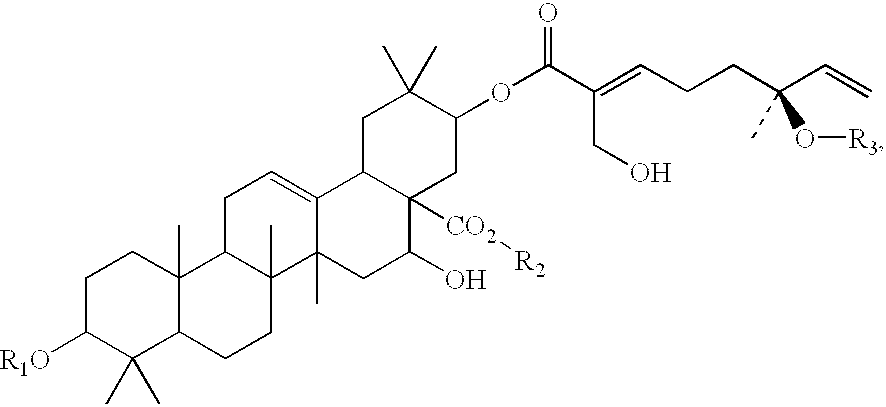Triterpene compositions and methods for use thereof
- Summary
- Abstract
- Description
- Claims
- Application Information
AI Technical Summary
Benefits of technology
Problems solved by technology
Method used
Image
Examples
example 2
Procedures for Isolating Active Constituents from Acacia victoriae
A procedure was developed for the direct preparation of fractions containing the active constituents contained in UA-BRF-004-DBLEP-F035, isolated during the preliminary purification detailed in Example 1. Approximately 9665 g of freshly collected pod tissue from Acacia victoriae was ground in a hammer mill with a 3 mm screen and then extracted with 80% MeOH in H.sub.2 O (3.times.) followed by filtration. 8200 g of bagasse was discarded. The three washings were collected separately and assigned fraction identifiers as follows: F068 in 21.5 L (first wash); F069 in 24 L (second wash); and F070 in 34.3 L (third wash). F068 was further purified by partitioning into 1 L aliquots, adding 400 ml H.sub.2 O to each aliquot and washing with CHCl.sub.3 (2.times.250 ml). The combined polar phases (28.5 L) were assigned the fraction identifier of F078 and the combined organic phases F079 (yielding 42. g after removal of the organic...
example 3
Preparative Scale Procedure for Preparing Active Constituents from Fraction UA-BRF-004-DELEP-F094
A modified extraction / separation procedure was used for the scaled-up preparation of mixtures of active constituents from fraction UA-BRF-004Pod-DELEP-F094 (F094). This procedure was repeated multiple times, consistently yielding highly active fractions. Typically, 20-25 g of F094 or its equivalent was dissolved in 150-175 ml of 50% MeOH in H.sub.2 O which was then aspirated onto a column ((26 mm.times.460 mm)+(70 mm.times.460 mm), RP-C 18, 40 .mu.m, 1200 g, equilibrated with 60% MeOH / H.sub.2 O). The fractions were eluted in steps of 8L in 60% MeOH / H.sub.2 O; 7.5 L 70% MeOH / H.sub.2 O; and 2L MeOH and assigned fraction identifiers as shown in Table 15. Fraction F035-B2 contains a mixture of the active components contained in F094, F133-136 (isolated from F093) and F138-147 (isolated from F094) as shown in FIGS. 18A-18F. F094 is an acceptable substitute for F035 with a one- to two-fold dec...
example 4
Alternative Procedures for Isolating Active Constituents from Acacia victoriae
Fractions F094 (250 g), F035 (50 mg), and Acacia victoriae ground pods (1 Kg) (i.e. seedpod powder) were obtained as described above. The analytical methodology used to analyze fraction F094 and the subsequent fractionation of the F094 are described in this example.
4.1 Analytical Methodology
Several methods involving various C8 and C18 columns under gradient and isocratic conditions were tried to resolve fraction F094. The monitoring included both UV at 220 nm and evaporative light scattering detection (ELSD). Better peak resolution was seen with mobile phases containing trifluoroacetic acid (TFA). The method, called herein as Acacia 257, is described below. This method provides good resolution along with a short run time.
The HPLC was equipped with a diode array detector (DAD) or variable wavelength detector and a 4.6.times.150 mm Inertsil C18 3.mu. column (MetaChem). The detector was set at 220 nm.
The foll...
PUM
| Property | Measurement | Unit |
|---|---|---|
| Temperature | aaaaa | aaaaa |
| Temperature | aaaaa | aaaaa |
| Temperature | aaaaa | aaaaa |
Abstract
Description
Claims
Application Information
 Login to View More
Login to View More - R&D
- Intellectual Property
- Life Sciences
- Materials
- Tech Scout
- Unparalleled Data Quality
- Higher Quality Content
- 60% Fewer Hallucinations
Browse by: Latest US Patents, China's latest patents, Technical Efficacy Thesaurus, Application Domain, Technology Topic, Popular Technical Reports.
© 2025 PatSnap. All rights reserved.Legal|Privacy policy|Modern Slavery Act Transparency Statement|Sitemap|About US| Contact US: help@patsnap.com



